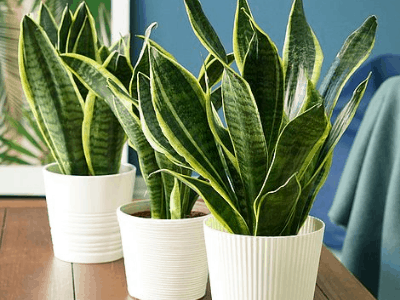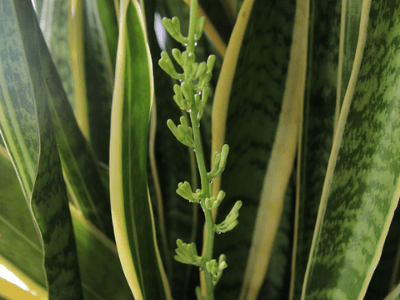
What is Snake Plant?
What is Sansevieria Laurentii?
Sansevieria or (san-se-vi-ah) in the Lily family, also known as one of the world’s most popular plants.
On the basis of molecular phylogenetic studies Sansevieria has been included in the genus Dracaena…
…which is native to tropical Africa in particular Madagascar, and southern Asia.
The 70 or so species formerly placed in the genus have been known by many common names….
…..including mother-in-law’s tongue, devil’s tongue, jinn’s tongue, bow string hemp snake plant, and snake tongue.
According to the APG III classification system, Dracaena is a member of the family Asparagaceae…
…subfamily Nolinoideae (formerly the family Ruscaceae).
It has also been placed in the family Dracaenaceae. With its durability, the Sansevieria makes an excellent choice…
…for apartment dwellers who typically have difficulty with houseplants due to limited lighting.
They should take a good look at snake plants. As the most tolerant of all decorative plants…
…Sansevieria can survive the harshest growing conditions, abuse and neglect.
Simply put, sansevieria is a tough houseplant to kill. Snake plants are versatile, classic houseplants…
…with sword-like foliage.
The great thing about this plant is that it’s a great plant for forgetful gardeners…
…and it’s an excellent air purifier plant for indoor environments.
Despite being a resilient succulent that can grow from 6 inches to several feet, snake plants have a number of health benefits.
Household plants are often strategically placed for decoration and to maintain good feng shui.
But did you know that some of these same plants also have some health benefits?
You might be surprised to learn that snake plants bring both health benefits and beauty to your home.
Keep reading to discover the snake plant’s benefits, how to care for one, and how to keep it alive.
Before that, here we have story from Kevin about his experience having Sansevieria Laurentii as his houseplant.
Let us hear Kevin’s story!

Sansevieria laurentii is also known as the variegated snake plant. These plants are low maintenance and can tolerate neglect and continue to grow beautifully. It has fleshy, deep greens that have sharp points.
Carley Miller, author from thegreenpinky.com
Best Perks of Having Sansevieria Laurentii
In spite of their spiky, sculptural leaves and low-maintenance requirements, snake plants are one of the easiest plants to care for indoors.
Sansevieria laurentii survival depends on minimal attention and they’re easily adapted to new locations and conditions.
Knowing how to grow and maintain Sansevieria laurentii will ensure you keep them looking their spiky best.
Just follow these basic instructions and you’ll be successful in growing snake plants.
Sansevieria Laurentii
The long, green spears of the Dracaena trifasciata Laurentii (variegated snake plant) give a continuous color….
…and elegance, adding the benefit of being one of the easiest plants to look after.
The serpentine plant, also called the die-hard of all plants, thrives inside and outside, requires very low water…
…and is oblivious to the amount of light that it receives. Snake plants also have other notable properties:
- Their leaves can grow from 3 to 4 feet tall.
- Their general watering schedule is every two to six weeks.
- They’re perfect for beginner gardeners, frequent travelers, or anybody who wants the perks of a living plant without the responsibilities.

Planting Instruction and Care For Sansevieria Laurentii
Regardless of the light or moisture exposure, your snake plant will probably flourish.
The popularity of the plant is based both on the beauty and robustness of its profoundly shaded green leaves and height.
It can be placed in environments from very bright light to rooms with almost no sunlight and it will adjust…
…but they are better suited to indirect, constant light in rooms.
They prefer temperatures between 70 and 90 degrees Fahrenheit, and will not tolerate temperatures below 50 or a spot near a drafty window.
If you grow a snake plant outside in a garden, keep it in a container to prevent it from spreading:
Watering and Nutrients For Sansevieria Laurentii
An overwatered snake plant does not tolerate it. It will rapidly develop root rot if the soil is too damp.
In case of doubt, err on the underwater side and do not depend on the surface of the ground as the dryness indicator.
To make sure that you don’t feel any moisture until waters, you must put your finger four inches in the ground.
A snake plant kept in bright light would need to be watered more often than one kept in a darker setting.
A snake plant should not be watered more than once every two weeks, and some can go up to six weeks…
…without having to be watered. The plant would need even less water in the winter.
Fertilizers made for cacti work well with snake plants (1-7-6).
Snake plants can only be fertilized during the growing season. If you’re going to use a slow-release fertilizer…
…dilute it to half strength first.
Sansevieria Laurentii is Though
Snake plants are drought resistant and seem to prefer to remain on the dry side. Plant them in soil that is loose and drains well.
A commercially prepared cactus mix is a good choice, as are other soils on the sandy side.
The roots of the snake plant are extremely strong, so you should plant them in sturdy pots devoid of cracks as their roots grow.
Terra cotta pots are a good choice, as they are lightweight and absorb excess water.
A snake plant kept in the sunshine will grow quickly, so anticipate repotting or dividing it once or twice a year…
…preferably in the spring. If your plant is pot bound it may flower.
Whenever you repot, provide your plant with fresh potting soil, and don’t bury them too deeply.
It’s a good idea to wipe down your leaves every once in a while, as they do collect dust.
Choose a container that has drainage holes in the bottom.

Watering and Nutrients For Sansevieria Laurentii
An overwatered snake plant does not tolerate it. It will rapidly develop root rot if the soil is too damp.
In case of doubt, on the underwater side and do not depend on the surface of the ground as the dryness indicator.
To make sure that you don’t feel any moisture until waters, you must put your finger four inches in the ground.
A snake plant kept in bright light would need to be watered more often than one kept in a darker setting.
A snake plant should not be watered more than once every two weeks, and some can go up to six weeks without having to be watered.
The plant would need even less water in the winter. Fertilizers made for cacti work well with snake plants (1-7-6).
Snake plants can only be fertilized during the growing season. If you’re going to use a slow-release fertilizer…
….dilute it to half strength first.
Propagation For Sansevieria Laurentii
Snake plants are very simple to propagate, especially through plant division. The rapid growth of a plant in a container…
…in a sunny location can necessitate division. Unpotting a plant and splitting the root ball and leaves…
…into many divisions is the simplest way to separate it. The roots and leaves will separate…
…and the plant will be ready for repotting. Cuttings may also be used to spread snake plants.
Simply snip off the top few inches of a leaf and drop it in the soil or into a cup of water.
It may grow roots, but this method may take longer and may result in the loss of the plant’s distinctive markings.
Pruning For Sansevieria Laurentii
Snake plants don’t need any pruning beyond removing any dead leaves or improving the plant’s appearance.
To ensure that the plant devotes its resources to safe new growth rather than repairing injuries…
…it is a good idea to remove damaged leaves.
Pests and Diseases For Sansevieria Laurentii
The snake plant’s hardiness extends to its pest and disease tolerance. Root rot can cause leaves to become soft…
….or brown, which you can treat by removing any infected leaves with a sharp scissor and allowing the plant to dry out.
Insect infestations are uncommon on snake plants. If mealybugs or spider mites appear…
…use neem oil or a solution of liquid soap and water to wipe down the leaves.
Light For Sansevieria Laurentii
The Snake Plant is extremely adaptable. While it can tolerate full sun, it prefers and thrives in indirect sunlight…
…and grow light. This makes it suitable for indoor cultivation. Indoor artificial lighting, such as fluorescent bulbs…
….used in most offices and homes, can provide enough light for this plant to thrive.
However, you’ll need more light intensity and duration to make it expand faster and more vigorously.
Flowering For Sansevieria Laurentii
Snake plant flowers range in color from green to white. Moths pollinate them in the open air.
After fruiting, these plants are known to produce very few seeds.
When a shoot blooms, it stops producing flowers and instead produces small plants that emerge from the rhizomes.

Sum Up
See having Snake plant is good choice for you to have! It’s cool, its famous, it’s easy to have and care!
Especially having Sansevieria Laurentii around you as your houseplant! What else do you need?
In this pandemic time like this, is a good choice for you to have an new activity and having snake plant is a good choice for you to have!
Conclusion
Last thing for sure. This plant need to be care carefully, remember plant need the “love” too.
Alright that’s all for today! Do you have any questions about all of this?
Or do you want to add some method for having and care of Sansevieria Laurentii?
Let me know your recommendation from the comment below.
I hope you can now take care your snake carefully and grow it big!
Thanks for reading this article! Bye!

